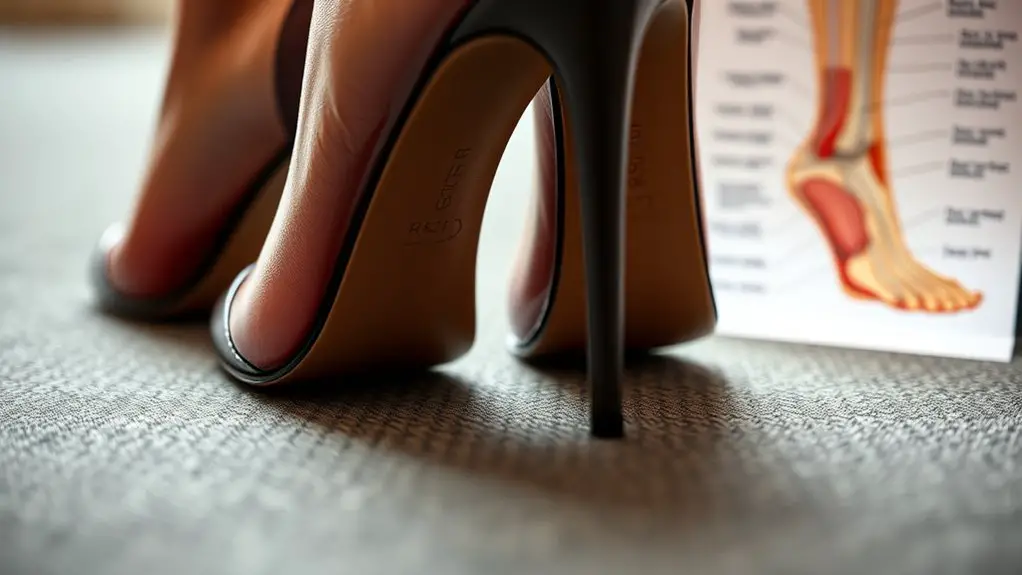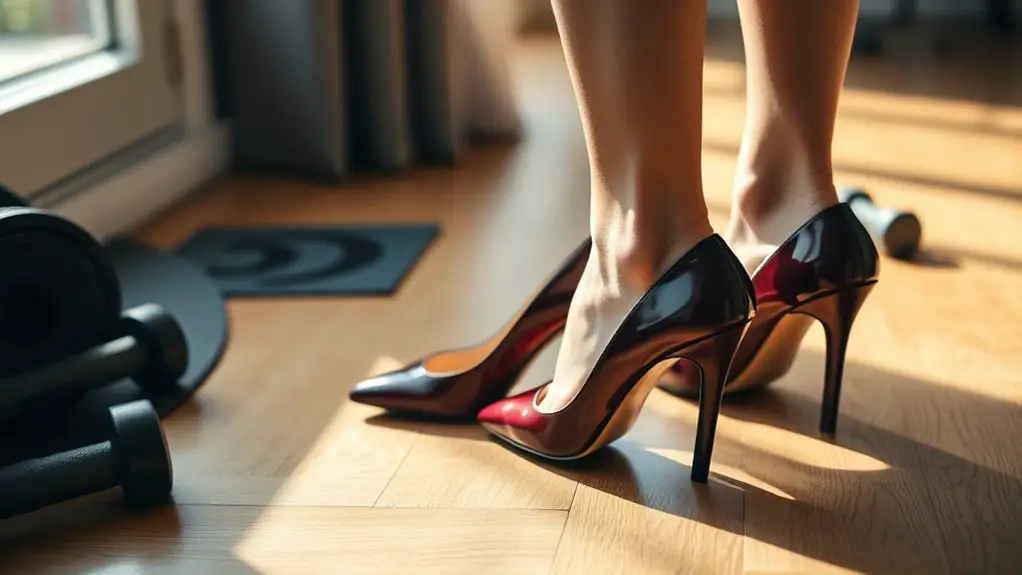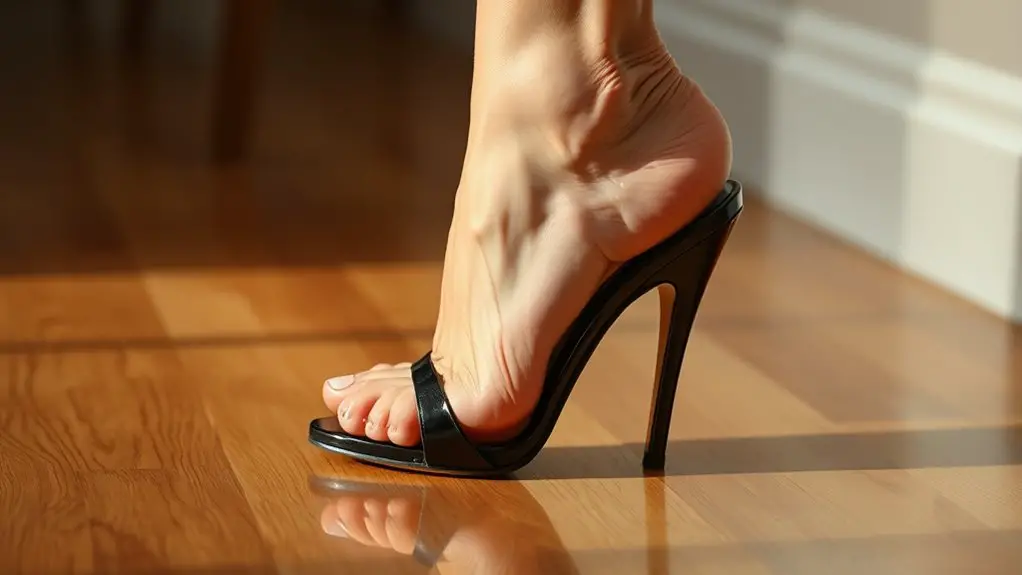Wearing heels can engage certain muscles in your feet, potentially leading to increased strength in those areas. However, the elevated position alters your foot alignment and shifts weight, which can increase the risk of injuries such as sprains and chronic pain. While some muscle adaptation may occur, the risks often outweigh the benefits. If you want to learn how to wear heels safely and strengthen your feet effectively, further insights are available.
The Anatomy of the Foot and Its Muscles

Although you may not think about it often, the foot is a complex structure consisting of bones, ligaments, and muscles that work together to provide stability and mobility. Your foot contains 26 bones, 33 joints, and over 100 muscles, tendons, and ligaments. This intricate foot structure is fundamental for maintaining balance and absorbing impact during activities like walking or running. The primary muscles, including the intrinsic and extrinsic groups, play a significant role in adapting to various surfaces and facilitating movement. Intrinsic muscles, located within the foot itself, support the arches and stabilize the toes, while extrinsic muscles, originating in the lower leg, control the foot’s motion. Understanding muscle function in the foot can help you appreciate how essential it is for overall mobility and strength. Proper foot care and exercise can enhance muscle performance, ensuring your feet remain strong and functional throughout your life.
How Heels Affect Foot Positioning
When you wear heels, your foot’s positioning changes considerably, impacting both balance and biomechanics. The elevated heel alters your foot alignment, shifting your weight forward. This can lead to increased pressure on the forefoot and an altered center of gravity, which may contribute to discomfort and fatigue over time.
| Aspect | Effect on Foot Positioning |
|---|---|
| Heel Position | Elevates the heel, tilting the foot forward |
| Foot Alignment | Causes misalignment in the ankle and knee joints |
| Weight Distribution | Shifts pressure from the heel to the forefoot |
| Balance Dynamics | Changes your overall balance, requiring adjustments |
Understanding these changes can help you make informed decisions about wearing heels. While they may enhance aesthetic appeal, it’s essential to reflect on how they affect your foot position and overall biomechanics. Long-term effects could lead to complications if proper care isn’t taken.
The Balance Factor: Engaging Stabilizing Muscles

As you navigate in heels, your body compensates for the altered center of gravity by engaging stabilizing muscles throughout your lower body. This dynamic shift requires your core, glutes, and hip stabilizers to work harder, promoting balance training. Research shows that wearing heels activates these stabilizing muscles, which are essential for maintaining proper posture and alignment.
When you wear heels, your body instinctively adjusts to prevent falls, leading to a more engaged musculature. This activation can enhance muscle endurance and coordination over time, potentially benefiting overall balance. However, the degree of engagement varies based on heel height and individual anatomical differences.
Regular practice in heels may lead to increased awareness of your body’s balance mechanisms, which can be beneficial in other activities. Consequently, while heels may provide a unique challenge, they also necessitate careful attention to the role of stabilizing muscles in maintaining equilibrium.
Potential Benefits of Wearing Heels
Wearing heels can offer a range of potential benefits that extend beyond aesthetics. For instance, incorporating heel fashion into your wardrobe can enhance your posture, making you appear taller and more confident. This change in stance may engage various muscle groups in your legs and feet, potentially improving muscle tone over time.
Moreover, choosing high-quality heels designed for comfort can promote foot aesthetics by encouraging proper alignment. Heels can also stimulate blood circulation in your feet, which might lead to enhanced foot health.
Additionally, wearing heels occasionally can provide a different sensory experience, helping your feet adapt to various surfaces and angles. While the primary allure of heels often lies in their stylish appeal, these potential benefits suggest that there’s more to them than just looks. Balancing aesthetics with foot strength can be beneficial when you choose wisely.
Risks and Drawbacks of High Heels

Wearing high heels can greatly increase your risk of injury, particularly ankle sprains and fractures. The elevated position alters your foot mechanics, which can lead to discomfort and long-term issues such as plantar fasciitis. Understanding these risks is essential for making informed choices about your footwear.
Increased Injury Risk
High heels may enhance your appearance, but they greatly increase the risk of injury. Wearing these shoes can lead to various issues, including ankle sprains, fractures, and chronic pain. Studies have shown that high heels alter your center of gravity, making you more susceptible to falls. This footwear selection often forces the foot into an unnatural position, further exacerbating the risk of injury. To prioritize injury prevention, it’s essential to contemplate alternatives that provide better support and stability. Opting for shoes with a lower heel and proper arch support can greatly reduce your chances of injury while still allowing you to enjoy stylish footwear. Always be mindful of how your shoe choices impact your overall foot health.
Altered Foot Mechanics
When you choose to wear high heels, the mechanics of your feet can be considerably altered, leading to a range of biomechanical issues. High heels shift your body’s center of gravity, resulting in altered biomechanics that can strain your muscles, ligaments, and joints. This shift affects pressure distribution across your foot, often concentrating excessive force on the forefoot and toes. Over time, this can lead to conditions like plantar fasciitis and metatarsalgia. Additionally, the unnatural position of the foot can cause imbalances in your gait, increasing the risk of injury not only to your feet but also to your knees and hips. Understanding these risks is crucial if you’re considering high heels as part of your footwear choices.
Comparing Heels to Other Footwear
When comparing heels to other types of footwear, heel height greatly influences foot mechanics and stability. Research indicates that higher heels can alter your center of gravity, potentially leading to decreased support and increased risk of injury. Understanding these differences is vital for making informed choices about your footwear.
Heel Height Impact
A significant difference in heel height can markedly influence foot biomechanics and overall comfort compared to other types of footwear. Higher heels shift your weight forward, altering the natural alignment of your feet and potentially leading to discomfort or injury. This change can impact your foot strength, as the muscles in your feet must work harder to maintain stability and balance. Conversely, lower heels or flat shoes allow for a more natural foot position, promoting better foot strength and reducing strain. Research indicates that consistent use of high heels may lead to muscle imbalances, while flatter footwear supports healthier biomechanics. As a result, understanding heel height’s impact is essential for maintaining ideal foot health and strength over time.
Stability and Support
While high heels may enhance aesthetic appeal, their lack of stability and support can greatly compromise foot health compared to other types of footwear. Proper footwear should prioritize foot alignment and arch support, which are often lacking in heels.
| Feature | High Heels |
|---|---|
| Stability | Limited |
| Arch Support | Minimal |
In contrast, supportive shoes provide better foot alignment, reducing the risk of injuries and discomfort. They distribute weight evenly, which enhances stability and promotes overall foot strength. Choosing footwear with adequate support is vital for maintaining long-term foot health, especially if you frequently wear high heels. Prioritizing stability and support can markedly impact your overall comfort and well-being.
Tips for Wearing Heels Safely
How can you guarantee comfort and safety while wearing heels? First, select the right heel types for your needs. Chunky heels offer better stability than stilettos, reducing the risk of ankle sprains. Next, pay attention to comfort levels; look for cushioned insoles and arch support, which can help distribute pressure evenly across your feet.
Additionally, practice walking in your heels before wearing them for extended periods. This can help you develop balance and confidence. It’s also wise to limit the height of your heels—staying below three inches is recommended for daily wear.
Lastly, give your feet regular breaks by alternating with more supportive footwear throughout the day. Keeping your feet flexible and strong will enhance your overall comfort and safety. By following these tips, you can enjoy wearing heels while minimizing potential discomfort and injury.
Exercises to Strengthen Feet and Ankles
Strengthening your feet and ankles is crucial for improving stability and reducing the risk of injuries, especially when wearing heels. Incorporating balance exercises into your routine can enhance proprioception and strengthen the muscles surrounding your ankles. Simple exercises like standing on one leg for 30 seconds or using a balance board can greatly improve your stability.
Additionally, ankle stretches are essential for maintaining flexibility and preventing strain. Try calf stretches by placing your hands against a wall and pushing one heel down while keeping the opposite leg bent. Hold for 15-30 seconds on each side.
Another effective stretch involves sitting with your legs extended and using a towel to pull your toes towards you, targeting the calf and Achilles tendon. Regularly incorporating these exercises and stretches can lead to stronger feet and ankles, ultimately reducing discomfort and injury while wearing heels.
Personal Experiences: Women and Heels
Many women report that wearing heels daily can contribute to foot strength, as the muscles in the feet adapt to the demands of elevated footwear. However, it’s also common to encounter personal injuries, such as sprains or plantar fasciitis, due to improper arch support or prolonged use. Understanding these experiences can provide valuable insights into the balance between style and foot health.
Strengthening Through Daily Wear
Although wearing heels is often criticized for its potential to cause foot problems, many women find that regular wear can lead to increased foot strength and stability over time. Engaging in daily wear of heels can activate various muscle groups in your feet, promoting strength and endurance. Studies suggest that consistent use may enhance the intrinsic muscles, which are crucial for foot stability. As your body adapts to the altered biomechanics of heels, you could experience improved balance and proprioception. Additionally, increased foot strength may help mitigate some risks associated with high-heeled footwear. While it’s essential to choose comfortable designs and take breaks, a strategic approach to heel wear can indeed bolster your foot strength over time.
Personal Injury Experiences
While wearing heels can promote foot strength, personal injury experiences reveal a complex relationship between high-heeled footwear and foot health. Many women report issues like plantar fasciitis, ankle sprains, and metatarsalgia after prolonged use of heels. These injuries highlight the significance of injury prevention strategies, such as choosing supportive footwear alternatives when possible. Research indicates that consistent heel wear can lead to muscle imbalances, increasing the risk of injury. Incorporating a variety of shoe styles, including flats or athletic shoes, can help mitigate these risks while allowing your feet to recover. Ultimately, understanding the potential consequences of high-heeled footwear is essential for making informed choices that prioritize both style and foot health.
Making Informed Footwear Choices
Making informed footwear choices is essential for maintaining foot health and overall well-being. You need to take into account various factors, including footwear materials and your style preferences, to select shoes that support your feet effectively. Here are some key considerations:
- Arch support: Look for shoes that offer adequate arch support to prevent strain.
- Cushioning: Choose materials that provide good cushioning to absorb impact, reducing stress on your joints.
- Breathability: Opt for breathable fabrics to keep your feet dry and comfortable, minimizing the risk of fungal infections.
- Fit: Verify your shoes fit well; avoid overly tight or loose options that can lead to blisters or discomfort.
- Heel height: Be mindful of heel height; excessive elevation can cause long-term foot problems.
Frequently Asked Questions
Do All Types of Heels Provide the Same Foot Strength Benefits?
Research shows that 80% of women wear heels regularly, but not all heel types provide the same foot strength benefits. Your fashion choices matter; stilettos may strain more than block heels, affecting overall foot health differently.
Can Wearing Heels Lead to Long-Term Foot Deformities?
Wearing heels can indeed lead to long-term foot deformities, negatively impacting your foot health. They often cause posture issues, increasing strain on ligaments and joints, which may result in conditions like bunions or hammer toes over time.
How Often Should One Wear Heels for Potential Benefits?
Think of your feet like delicate flowers; too much daily wear of heels can stifle their growth. Ideally, limit heel frequency to special occasions to balance style and foot health without risking long-term issues.
Are There Specific Heel Heights That Are Safer for Foot Strength?
Yes, specific heel heights can influence foot alignment. Generally, heels between one and two inches maintain better foot alignment, reducing strain. Higher heels may disrupt balance and negatively impact foot strength over time, so moderation is key.
Can Men Benefit From Wearing Heels for Foot Strength?
Think of your feet like a muscle-bound athlete; they need diverse challenges. Men can benefit from heel adaptability, as it promotes muscle engagement, potentially enhancing foot strength while ensuring safer, controlled movements over time.



